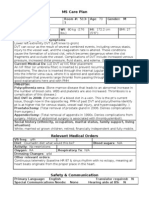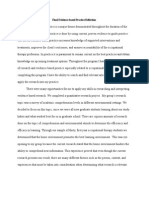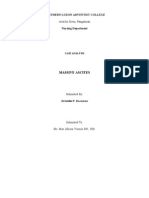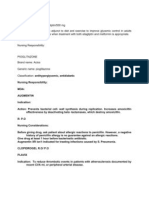Cancer #1 Case Study - Coreweek One
Cancer #1 Case Study - Coreweek One
Uploaded by
Dragan DjordjevicCopyright:
Available Formats
Cancer #1 Case Study - Coreweek One
Cancer #1 Case Study - Coreweek One
Uploaded by
Dragan DjordjevicCopyright
Available Formats
Share this document
Did you find this document useful?
Is this content inappropriate?
Copyright:
Available Formats
Cancer #1 Case Study - Coreweek One
Cancer #1 Case Study - Coreweek One
Uploaded by
Dragan DjordjevicCopyright:
Available Formats
Case Study 92
Djordjevic Dragan
Scenario R.T. is a 64-year-old man who comes to his primary care providers (PCPs) office for a yearly examination. He initially reports having no new health problems; however, on further questioning, he admits to having developed some fatigue, abdominal bloating, and intermittent constipation. His nurse practitioner completes the examination, which includes a normal rectal exam with a stool positive for guaiac. Diagnostic studies include a CBC with differential, chem 14, and carcinoembryonic antigen (CEA). R.T. has not had a recent colonoscopy and is referred to a gastroenterologist for this procedure. A 5-cm mass found in the sigmoid colon confirms a diagnosis of adenocarcinoma of the colon. A referral is made for surgery. The pathology report describes the tumor as a Dukes stage B, which means that the cancer has extended into the mucous layer of the colon. A metastatic work-up is negative. 1. What is a risk factor? 64-year-old (no information about heredity, diet, polyps, etc) . 2. Identify six risk factors for colon cancer. Age older than 50 yo Polyps of the colon / rectum Family Hx of colorectal cancer Inflammatory bowel disease Exposure to radiation Diet: high animal fat and kilocalorie intake 3. Discuss the American Cancer Societys recommended screening procedures related to colon cancer. Screening is recommended beginning at age 50. Yearly fecal occult blood / fecal immunochemical test (take home, multiple sample); flexible sigmoidoscopy every 5 years; double-contrast barium enema every 5 years; colonoscopy q 10 years. 4. According to the American Cancer Society, what warning signs did R.T. have? stool positive for guaiac = rectal bleeding abdominal bloating, and intermittent constipation 5. Discuss common early versus late signs and symptoms (S/S) found in individuals with colorectal cancer. Often there's no Sx until advanced (grows slowly 5-15 years). Manifestations depend on its location, type and extent, complication. Rectal bleeding is initial Sx, than change in bowel habits (diarrhea / constipation). Advanced disease Sx: pain, anorexia, weight loss, palpable abdominal / rectal mass, anemia. 6. What is a CEA? How does it relate to the diagnosis of colon cancer? Carcinoembryonic antigen (CEA) is a tumor marker that can be detected in the blood of clients with colorectal cancer. CEA level is used to estimate prognosis, monitor treatment, and detect cancer recurrence.
7. After bowel prep, R.T. is admitted to the hospital for an exploratory laparotomy, small bowel resection, and sigmoid colectomy. List at least five major potential complications for Infection (Leakage from Colon) Bleeding Blood Clots Damage to Internal Organs bulging of tissue through surgical incision colon blockage due to the formation of scar tissue incomplete joining of the reattached sections of your colon and rectum 8. After surgery, R.T. is admitted to the surgical intensive care unit (SICU) with a large abdominal dressing. The nurse rolls R.T. side to side to remove the soiled surgical linen, and the dressing becomes saturated with a large amount of serosanguineous drainage. Would the drainage be expected after abdominal surgery? Explain. Serosanguineous drainage is expected after abdominal surgery because of incision and time needed for clotting process. It is not normal if the bandage is soaked with blood, if green or yellow drainage is coming from it, or patient have black or tarry stools, or there is blood in his stool. 9. Four weeks after surgery, R.T. is scheduled to begin chemotherapy. List three chemotherapy drugs used to treat adenocarcinoma of the colon. 5-Fluorouracil (5-FU) folinic acid (leucovorin) Irinotecan (CPT-11)
10. Discuss some of the toxicities and side effects of these drugs. Side effects include myelosuppression, mucositis, dermatitis and diarrhea. 5-FU injection and topical even in small doses cause both acute central nervous system (CNS) damage and progressively worsening delayed degeneration of the CNS. Serious adverse reactions to fluorouracil are; chest pain, EKG changes and increases in cardiac enzymes - which may indicate problems with the heart. Folinic acid is also used in combination with the chemotherapy agent 5-fluorouracil in treating colon cancer. In this case, folinic acid is not used for "rescue" purposes; rather, it enhances the effect of 5-fluorouracil by inhibiting thymidylate synthase. Adverse effects of irinotecan treatment include severe diarrhea, myelosuppression, and neutropenia. 11. Given the side effect profiles of the drugs used to treat colon cancer, develop a teaching plan for R.T. Contact your health care provider immediately if you should experience any of the following symptoms: Fever of 100.5 F (38 C) or higher, chills (sx of infection). Avoid crowded places. Contact your health care provider within 24 hours of noticing any of the following: Nausea, vomiting more than 4-5 times in a 24 hour period, diarrhea (4-6 episodes in a 24-hour period), unusual bleeding or bruising, black or tarry stools, or blood in the stools or urine, extreme fatigue, mouth sores, tingling or burning, redness, swelling of the palms of the hands or soles of feet.
You might also like
- Case Study 51 Acute PancreatitisDocument6 pagesCase Study 51 Acute PancreatitisKelsey LloydNo ratings yet
- Harrisons Principles of Internal Medicine 21st Edition Vol 1 Vol Split PDF 1694700703964Document73 pagesHarrisons Principles of Internal Medicine 21st Edition Vol 1 Vol Split PDF 1694700703964Clorinda RodriguezNo ratings yet
- Case 55 BPHDocument4 pagesCase 55 BPHGetachew Addis75% (12)
- Care Plan For Bowel ResectionDocument4 pagesCare Plan For Bowel Resectionviki840488% (8)
- Conzace Tranexamic MetoclopramideDocument5 pagesConzace Tranexamic MetoclopramideDivine Mercy De JulianNo ratings yet
- Drug Potassium Chloride KCLDocument1 pageDrug Potassium Chloride KCLSrkocher100% (3)
- COPD Case StudyDocument4 pagesCOPD Case StudyPj Declarador100% (4)
- Congestive Heart Failure Schematic DiagramDocument1 pageCongestive Heart Failure Schematic DiagramCyrus De Asis100% (1)
- Anatomy and Physiology-Liver CirrhosisDocument2 pagesAnatomy and Physiology-Liver CirrhosisHilmi Ramos100% (3)
- TahbsoDocument4 pagesTahbsomichZ_13No ratings yet
- Case Study Heart Attack PDFDocument30 pagesCase Study Heart Attack PDFtkgoon634950% (2)
- SbarDocument2 pagesSbarbojums100% (2)
- Colorectal CancerDocument14 pagesColorectal Cancershaqtim100% (2)
- Abdominal Stab Wound Case StudyDocument36 pagesAbdominal Stab Wound Case StudyMean Elepaño80% (5)
- Case Study Final PortraitDocument11 pagesCase Study Final PortraitZhy CaluzaNo ratings yet
- Nursing Care PlanDocument12 pagesNursing Care Planzsazsageorge86% (21)
- NURSING CARE PLAN FOR CROHN'sDocument2 pagesNURSING CARE PLAN FOR CROHN'sMuhyeeSalaIdjadNo ratings yet
- DM - Case Pres 1aDocument59 pagesDM - Case Pres 1abon clayNo ratings yet
- NCP Ineffective Breathing GunshotDocument3 pagesNCP Ineffective Breathing GunshotMikko Enoc100% (1)
- Discharge PlanDocument3 pagesDischarge PlanBALOGO TRISHA MARIENo ratings yet
- AlgesiaDocument1 pageAlgesiaenirdnas14100% (2)
- CVADocument116 pagesCVAkathy50% (2)
- Care Plan For Excess Fluid Volume ExampleDocument3 pagesCare Plan For Excess Fluid Volume ExampleVette Angelikka Dela CruzNo ratings yet
- Case Study Ugib Lower MBDocument65 pagesCase Study Ugib Lower MBQuolette Constante100% (1)
- Atorvastatin Drug StudyDocument2 pagesAtorvastatin Drug StudyRenzo MarcosNo ratings yet
- Final Eb ReflectionDocument2 pagesFinal Eb Reflectionapi-238460511No ratings yet
- Drug Study ICUDocument15 pagesDrug Study ICUJulie Nambatac100% (1)
- Sodoso - Unit Task - M6Document3 pagesSodoso - Unit Task - M6Wench Ryechelle SodosoNo ratings yet
- DuphalacDocument2 pagesDuphalacianecunarNo ratings yet
- RNPIDEA-Coronary Artery Disease Nursing Care PlanDocument8 pagesRNPIDEA-Coronary Artery Disease Nursing Care PlanAngie MandeoyaNo ratings yet
- Impaired Tissue Perfusion Related To The Weakening / Decreased Blood Flow To The Area of Gangrene Due To Obstruction of Blood VesselsDocument3 pagesImpaired Tissue Perfusion Related To The Weakening / Decreased Blood Flow To The Area of Gangrene Due To Obstruction of Blood VesselsKat AlaNo ratings yet
- Drug StudyDocument7 pagesDrug StudyKynaWeeNo ratings yet
- Massive AscitesDocument12 pagesMassive Ascitesranitidin100% (1)
- Pneumo HemothoraxDocument126 pagesPneumo HemothoraxLyra Jan Roo100% (1)
- Chronic Kidney DiseaseDocument36 pagesChronic Kidney Diseasejabir100% (1)
- NCP DMDocument21 pagesNCP DMKate ManalastasNo ratings yet
- The Difference Between Community Health and Public Health NursingDocument1 pageThe Difference Between Community Health and Public Health NursingMelissa Briggs100% (1)
- Nursing Care Plan of Client With Fluid and Electrolyte ImbalanceDocument28 pagesNursing Care Plan of Client With Fluid and Electrolyte ImbalanceCj Aguilar50% (2)
- NCP IschemicDocument19 pagesNCP IschemicChristina Espiña EjercitoNo ratings yet
- Discharge Instructions For Lap CholeyDocument1 pageDischarge Instructions For Lap CholeyAnne Marie Angelica BilonoNo ratings yet
- Case Study - Dengue Fever V - S UtiDocument12 pagesCase Study - Dengue Fever V - S UtiHarlene Joyce ReyNo ratings yet
- NCP BleedingDocument3 pagesNCP Bleedingapi-316491996No ratings yet
- Drug StudyDocument9 pagesDrug StudyJonica CamposNo ratings yet
- Drug Study - CholangioDocument10 pagesDrug Study - CholangioClaireMutiaNo ratings yet
- 13 Areas of AssessmentDocument10 pages13 Areas of Assessmentobietobi50% (2)
- Hyponatremia Algorhythm Concept MapDocument2 pagesHyponatremia Algorhythm Concept Mapnursing concept mapsNo ratings yet
- Drug StudyDocument2 pagesDrug StudyLorina Lynne ApelacioNo ratings yet
- Case For NCPDocument5 pagesCase For NCPSarah Jane MaganteNo ratings yet
- Palmar Long Quiz Ratio AnswersDocument153 pagesPalmar Long Quiz Ratio AnswersPatrisha May MahinayNo ratings yet
- Cellulitis Discharge PlanDocument1 pageCellulitis Discharge PlanJuvy Rose Tinga YeeNo ratings yet
- Discharge Planning PaperDocument5 pagesDischarge Planning Paperapi-283173905No ratings yet
- ASSESSMENTDocument2 pagesASSESSMENTColeen PequitNo ratings yet
- Drug StudyDocument3 pagesDrug StudyKristine Joy A. AniNo ratings yet
- 13 Areas of AssessmentDocument6 pages13 Areas of Assessmentdanna christine g. paguntalanNo ratings yet
- Altretamine: Drug DosageDocument16 pagesAltretamine: Drug DosagePrincess CruzNo ratings yet
- Ventricular Septal Defect, A Simple Guide To The Condition, Treatment And Related ConditionsFrom EverandVentricular Septal Defect, A Simple Guide To The Condition, Treatment And Related ConditionsNo ratings yet
- The Ride of Your Life: What I Learned about God, Love, and Adventure by Teaching My Son to Ride a BikeFrom EverandThe Ride of Your Life: What I Learned about God, Love, and Adventure by Teaching My Son to Ride a BikeRating: 4.5 out of 5 stars4.5/5 (2)
- A Simple Guide to Abdominal Aortic Aneurysm, Diagnosis, Treatment and Related ConditionsFrom EverandA Simple Guide to Abdominal Aortic Aneurysm, Diagnosis, Treatment and Related ConditionsNo ratings yet
- Community Acquired Pneumonia, A Simple Guide To The Condition, Diagnosis, Treatment And Related ConditionsFrom EverandCommunity Acquired Pneumonia, A Simple Guide To The Condition, Diagnosis, Treatment And Related ConditionsNo ratings yet
- ABO and RH Blood Group SystemDocument31 pagesABO and RH Blood Group SystemKaab Ishaq100% (1)
- QuestionsDocument3 pagesQuestionsChi ChiNo ratings yet
- Activity 9 Phylum NematodaDocument18 pagesActivity 9 Phylum Nematodanicole syNo ratings yet
- 2019E 14 - Supportive Care and Managment of Side EffectsDocument82 pages2019E 14 - Supportive Care and Managment of Side Effectsrusgal8992No ratings yet
- Analytical Exposition Text Kel 5Document11 pagesAnalytical Exposition Text Kel 5Oja JamaludinNo ratings yet
- Management of Gastroesophageal Reflux in Elderly: Dr. Johanes Intandri Tjundawan SP - PDDocument42 pagesManagement of Gastroesophageal Reflux in Elderly: Dr. Johanes Intandri Tjundawan SP - PDPrimarini RiatiNo ratings yet
- The Three Clusters of Personality DisordersDocument3 pagesThe Three Clusters of Personality DisordersRaffNo ratings yet
- Apheresis: (Principle & Clinical Applications)Document35 pagesApheresis: (Principle & Clinical Applications)aprinalNo ratings yet
- Nasal Glioma A Rare Case in Maxillofacial Surgery Practice A Case ReportDocument5 pagesNasal Glioma A Rare Case in Maxillofacial Surgery Practice A Case ReportInternational Journal of Innovative Science and Research TechnologyNo ratings yet
- ER CASE CONFERENCE - Melena 8 - 31 - 21Document33 pagesER CASE CONFERENCE - Melena 8 - 31 - 21Jolaine ValloNo ratings yet
- Diphenhydramine Drug StudyDocument2 pagesDiphenhydramine Drug StudyMorrin MylesNo ratings yet
- Acute Kidney Injury, Dengue Shock Syndrome, and Severe DehydrationDocument28 pagesAcute Kidney Injury, Dengue Shock Syndrome, and Severe DehydrationPuskesmas BuloilaNo ratings yet
- Activity1 Cancer Gene CardsDocument14 pagesActivity1 Cancer Gene CardsIsmael FernandezNo ratings yet
- Mutraghat ADocument20 pagesMutraghat AGAURAVNo ratings yet
- What Is A Heart AttackDocument2 pagesWhat Is A Heart AttackMaya Sari HalimNo ratings yet
- Necrotizing Enterocolitis ProtocolDocument3 pagesNecrotizing Enterocolitis Protocoleddy riachyNo ratings yet
- Nhs Bronchiolitis Pathway Acute Setting South East Coast SCNDocument2 pagesNhs Bronchiolitis Pathway Acute Setting South East Coast SCNdrgrizahNo ratings yet
- Tryptomer 10 MG Tablet - Uses, Side EffectsDocument9 pagesTryptomer 10 MG Tablet - Uses, Side EffectsVishu SinghNo ratings yet
- Case Study - Case DFU (Question)Document6 pagesCase Study - Case DFU (Question)Kazmanie KamaruzamanNo ratings yet
- Maple Syrup Urine DiseaseDocument8 pagesMaple Syrup Urine DiseaseRon CorderoNo ratings yet
- Thyroid StormDocument15 pagesThyroid Stormdr_arvindanNo ratings yet
- Sulfonamides 3Document6 pagesSulfonamides 3saqib islamNo ratings yet
- Lesson Plan ImnciDocument8 pagesLesson Plan ImnciBhardwaj Lokesh50% (2)
- Blood Bank ReviewerDocument36 pagesBlood Bank ReviewerDixie Martonito100% (1)
- Acute Rheumatic FeverDocument26 pagesAcute Rheumatic FeverAshvanee sharma100% (1)
- Sputum CultureDocument6 pagesSputum CulturePranav Kumar PrabhakarNo ratings yet
- PMLS 1ppt 1Document60 pagesPMLS 1ppt 1Reon PytoNo ratings yet
- Thesis On Rheumatic Heart DiseaseDocument8 pagesThesis On Rheumatic Heart Diseaseolgabautistaseattle100% (2)
- BookDocument11 pagesBookNeeru GuptaNo ratings yet

























































































